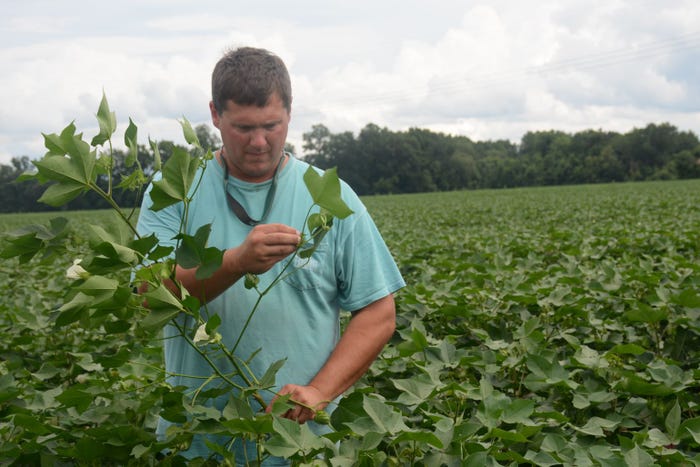
Thomas Sugg loved cotton and wanted to grow the crop on his farm near Snow Hill in North Carolina’s Greene County.
In the late 1980s, a handful of farmers in the area began trying their hands at growing cotton, a crop that had lost favor in the Coastal Plain due to the boll weevil and better returns for other crops. Thanks to the boll weevil eradication program, cotton, which had been a big crop in Greene County in the 1940s and 1950s, made a return starting in 1987. This piqued Sugg’s interest and in 1991. He jumped in, producing his first crop, a crop that he has grown ever since and plans to stay with in the years to come.
“Back then, I talked to my dad and my brother and said ‘Let’s grow some cotton,’” Sugg explains. “Up until then, we always grew corn, soybeans and tobacco, but I really wanted to try cotton. They said ‘Let’s go ahead and give it a try,'"
It’s a decision that Sugg doesn’t regret one bit. “Cotton still gives us the best opportunity to make a yield, and to make a crop, compared to corn or soybeans in our area. We stuck with it and kept on going,” Sugg says.
The Suggs target their cotton varieties to different soil types on a field-to-field basis, determining where each variety fits best. “With prices the way they are, we really need to place a variety where it will perform best. We have to have yield to overcome low prices,” Sugg says.
Unfortunately, wet weather at harvest pretty much devastated the Sugg’s cotton crop both in 2015 and last year. “For the last couple of years, we planted varieties that offered great yield potential, but we never got a true fix on what the yield could be because the crop was annihilated by storms,” he says.
Needless to say, the family is hoping for dry, cooperative weather at harvest this year. So far the Sugg’s cotton crop looks excellent with the potential for banner yields.
“Our strategy is to do the best possible job that we can do in the field. We always say we have to keep ourselves in a position to win. We give it everything we can and do the best that we can,” Sugg says.
Today, Sugg and his son Christopher are managing multiple crops together. “We work well together,” Sugg says.This year, they are growing 1,180 acres of cotton, along with peanuts (both runners and Virginias), soybeans, tobacco and some produce.
Both Thomas and Christopher say that you get as much out of something as you put in it. However, with their cotton they credit the germplasm in modern varieties that allows for better yields and improved fiber quality.
“We’re always going for improved yields and fiber quality,” Thomas says. “We’re trying to be as productive as we can.”
Sugg is a member of Deltapine’s New Product Evaluator program. The NPE program is in its 10th season this year with nearly 200 growers from across the Cotton Belt evaluating precommercial varieties. Sugg has been a part of the program since it began in 2008.
“The NPE program has brought better varieties to the marketplace,” he says. “They offer real advantages in terms of yield and fiber quality. Each one of the varieties is a step forward and they are always better. In the past 10 years, it’s never gone backwards. It’s always gone forward and the varieties have always improved.”
Sugg says a great value of the NPE program is the networking opportunity it provides to meet with other cotton farmers across the country, to learn from them and to compare notes.
“The NPE program provides a valuable information exchange. We all grow under different conditions, different part of the country and different soil types, but we still learn from each other,” he explains. “We’ve met a lot of great people through this program and made a lot of friends. The NPE program is like family.”
Sugg plants all of his cotton to varieties that come out of the NPE program. This year, the family planted the varieties DP 1725 B2XF, DP 1646 B2XF, DP 1639 B2XF, DP 1614 B2X, DP 1538 B2XF and DP 1522 B2X. “We have a buffet line going on out there with all of the different varieties,” Sugg says.
This year, the Suggs are evaluating lines that may become a part of Deltapine’s Class of 2018 of varieties if they make the cut. In their NPE trials, the Suggs are evaluating four potential varieties with 15 acres planted to each cultivar.
So far, Sugg says the new varieties look outstanding and show promise for outstanding yields. “I really like what I’m seeing,” he says.
The family works closely with Keylon Gholston, Monsanto cotton product manager, who gathers information on the experimental lines twice a year, once during the growing season and once again right after harvest.

Christopher Sugg checks the nodes on a pre-commercial cotton variety his family is producing as part of Deltapine’s New Product Evaluator Program.
.
About the Author(s)
You May Also Like






